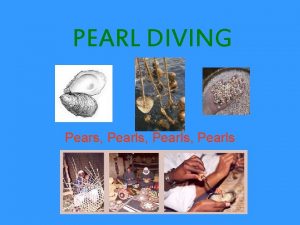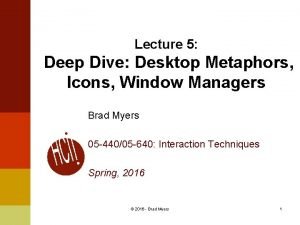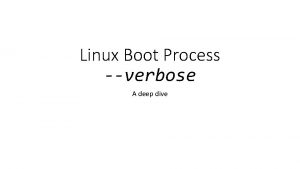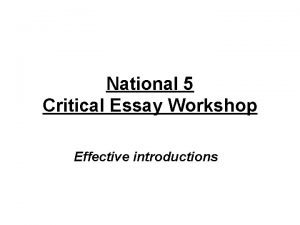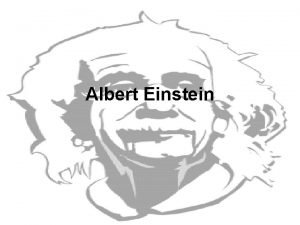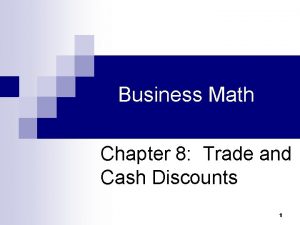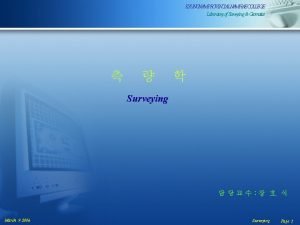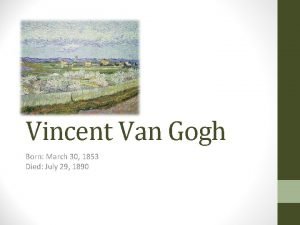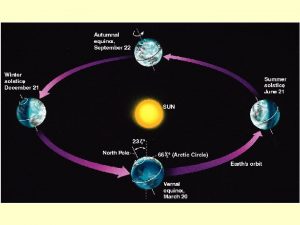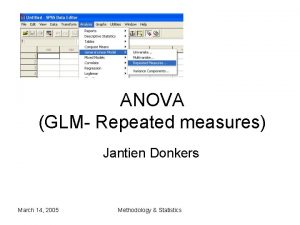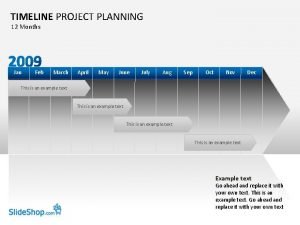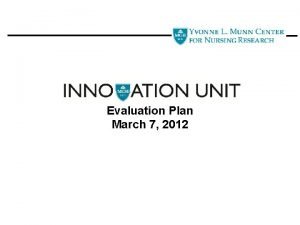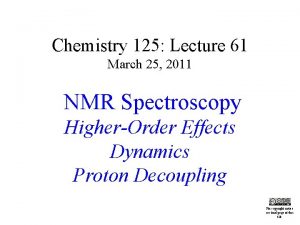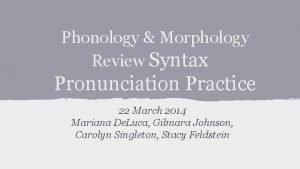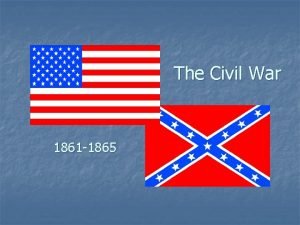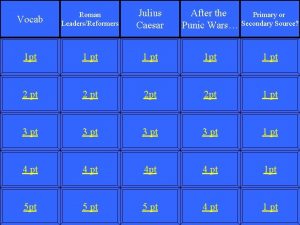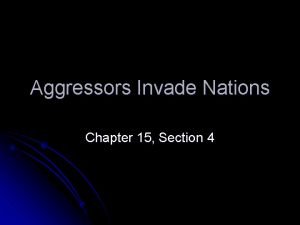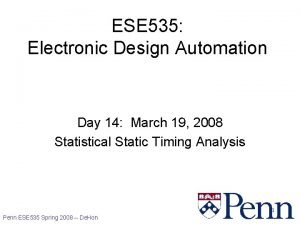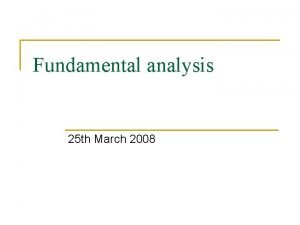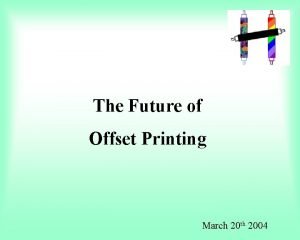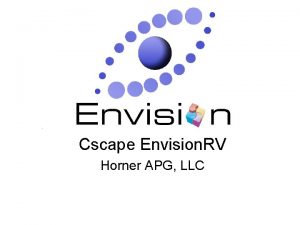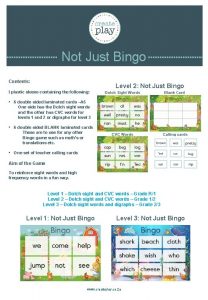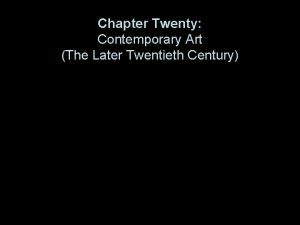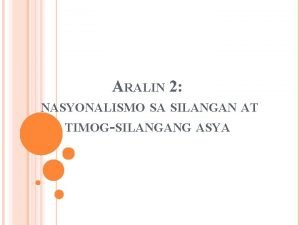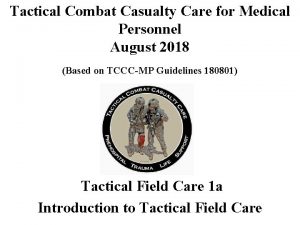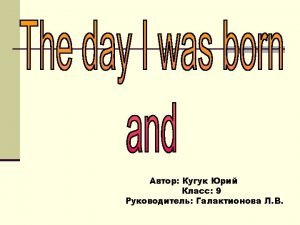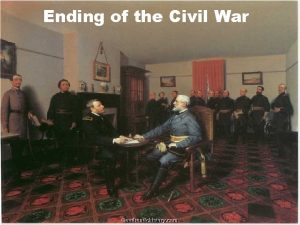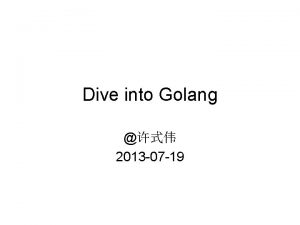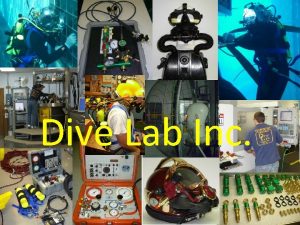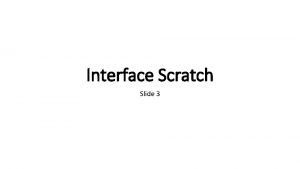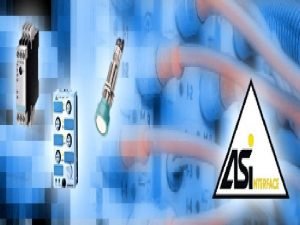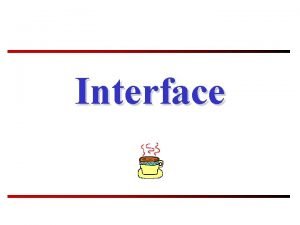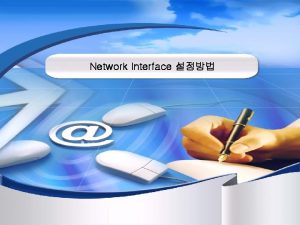2 IC Interface Technical Deep Dive March 2018





















































































































- Slides: 117

2 IC Interface Technical Deep Dive March 2018 1

TI Training - summary I 2 C Summary: This training will focus on the I 2 C protocol and the challenges our customer designer’s face when using this standard. Topics covered will include basic I 2 C protocol, challenges/tradeoffs of I 2 C, and how TI products help overcome these problems. What you’ll learn: • Learn I 2 C Protocol • Understand I 2 C challenges • Provide solutions to problems 2

Detailed Agenda • Overview of I 2 C – Hardware – Protocol • Devices – – Translators Switches Buffers I/O Expanders 3

I 2 C interface products Translators Repeaters Switches IO expanders I 2 C 1 I 2 C … IO 1 IO 2 IO 3 Special function I 2 C ION I 2 C 2 • Level-shifter • Bus Isolation • LED driver • Static offset buffer • Hot-swappable buffer • Bus extender • 1: 2, 1: 4, 1: 8 • 4 -, 8 -, 16 -, 24 -bit • Level-shifting switches • Level-shifting expanders • Interrupt switching • Open drain, push-pull IOs • Level-shifter 4

I 2 C Overview Hardware 5

2 IC History and Overview: History and I 2 C Devices 6

2 IC History and Overview: History and I 2 C Devices 7

Features of I 2 C Interface 8

Features of I 2 C Interface 2 wire bus • SDA (serial data line) • SCL (serial clock line) 9

Features of I 2 C Interface Open Drain or Collector Driver with Input Buffer that supports Bidirectional Data 10

Features of I 2 C Interface Open Drain/Collector Driver with Input Buffer that supports Bidirectional Data DATA 11

Features of I 2 C Interface Open Drain/Collector Driver with Input Buffer that supports Bidirectional Data 12

Features of I 2 C Interface Open Drain/Collector Driver with Input Buffer that supports Bidirectional Data DATA 13

2 IC Interface: General Operations 14

2 IC Physical Layer: Hardware VSCL(t) VCC VIH VIL VOL ON=LOW t 15

2 IC Physical Layer: Hardware VSCL(t) VCC VIH VIL VOL ON=LOW OFF=HIGH t 16

2 IC Physical Layer: Hardware VSCL(t) Rise Time (ns) VCC VIH VIL VOL ON=LOW OFF=HIGH t 17

Features of I 2 C Interface Addressing is accomplished with the SLAVE’s hardware address. Two Possible addressing modes: – 7 -bit address – 10 -bit address 18

Features of I 2 C Interface Standard Mode Fast Mode Plus 0 to 100 k. Hz 0 to 400 k. Hz 0 to 1, 000 k. Hz CBUS MAX = 400 p. F CBUS MAX = 550 p. F t. RISE MAX = 1, 000 ns t. RISE MAX = 300 ns t. RISE MAX = 120 ns 19

Features of I 2 C Interface The I 2 C bus is a very popular and powerful bus used for communications between a master (or multiple masters) and a single or multiple slave devices (aka ICs) Ability to add more devices in parallel by just connecting to the bus. Ease of expansion. 20

Features of I 2 C Interface The I 2 C bus is a very popular and powerful bus used for communications between a master (or multiple masters) and a single or multiple slave devices (aka ICs) Ability to add more devices in parallel by just connecting to the bus. Ease of expansion. 21

Features of I 2 C Interface The I 2 C bus is a very popular and powerful bus used for communications between a master (or multiple masters) and a single or multiple slave devices (aka ICs) Ability to add more devices in parallel by just connecting to the bus. Ease of expansion. 22

Features of I 2 C Interface The I 2 C bus is a very popular and powerful bus used for communications between a master (or multiple masters) and a single or multiple slave devices (aka ICs) Ability to add more devices in parallel by just connecting to the bus. Ease of expansion. 23

Benefits and Limitations of I 2 C Pros • Simple • Low Cost • Robust • Standardized • Wide assortment of peripherals • No need for termination • Easy Bus Expansion Cons • Low speed • Bus Capacitance Limited • Limits Speed • Limits distance • Half Duplex Only • No suited for ~long distances 24

Benefits and Limitations of I 2 C Pros • Simple • Low Cost • Robust • Standardized • Wide assortment of peripherals • No need for termination • Easy Bus Expansion Cons • Low speed • Bus Capacitance Limited • Limits Speed • Limits distance • Half Duplex Only • No suited for ~long distances 25

I 2 C Overview Protocol 26

I 2 C Interface: Bus Control: START and STOP Conditions A high-to-low transition on the SDA line while the SCL is high defines a START condition. A low-to-high transition on the SDA line while the SCL is high defines a STOP condition. 27

I 2 C Interface: Signals (SDA and SCL) 28

I 2 C Interface: Logic Levels and Timing The I 2 C standard specifies that the VIH and VIL be 70% and 30% of VCC respectively. The Logic level VSCL(t) Rise Time (ns) VCC VIH VIL VOL ON=LOW OFF=HIGH t 29

I 2 C Interface: Byte Format 30

I 2 C Interface: Repeated START Condition 31

I 2 C Interface: Data Validity and Byte Format 32

I 2 C Interface: Acknowledge (ACK) - Not Acknowledge (NACK) There are several conditions that lead to the generation of a NACK: 1. The receiver is unable to receive or transmit because it is performing some real-time function and is not ready to start communication with the master. 2. During the transfer, the receiver gets data or commands that it does not understand. 3. During the transfer, the receiver cannot receive any more data bytes. 4. A master-receiver is done reading data and indicates this to the slave through a NACK. 33

I 2 C Interface: Clock Stretching 34

I 2 C Interface: Other I 2 C Based Protocols • System Management Bus (SMBUS) • Power Management Bus (PMBUS) • Intelligent Platform Management Interface (IPMI) • Display Data Channel (DDC) • Advanced Telecom Computing Architecture (ATCA) 35

I 2 C Data : Writing to a Slave on the I 2 C Bus Example of Writing a single byte to a Slave register: 36

I 2 C Data : Reading from a Slave on the I 2 C Bus Example of Reading a single register byte from a Slave register: 37

I 2 C Physical Layer: Hardware 38

I 2 C Physical Layer: Hardware (LOW) Lets look at the physics of the High and Low generation. The SCL and SDA line will be treated as same. LOW: When Master Pulls SCL to ground for logic low. IOL + VOL _ Fall Time tf 39

I 2 C Physical Layer: Hardware (HIGH) Lets look at the physics of the High and Low generation. The SCL and SDA line will be treated as same. HIGH: When Master releases SCL from ground, RPULLUP raises bus to VCC for logic high. Rise Time tr 40

I 2 C Physical Layer: Bus Capacitance & Rise Times Example: Standard Mode, Cb = Cb(max) = 400 p. F, VCC = 3. 3 V 41

Translators 42

Translation of I 2 C Bus What happens when two devices need to operate at different V CC values? 43

Translation of I 2 C Bus Pass Elements Based Devices 44

Translation of I 2 C Bus PCA 9306 – Pass FET Architecture = 1. 8 V = 5. 0 V + _VGS 45

Translation of I 2 C Bus PCA 9306 – Pass FET Architecture = 1. 8 V = 5. 0 V + V _ GS = 2. 5 V 46

Translation of I 2 C Bus PCA 9306 – Pass FET Architecture = 1. 8 V = 5. 0 V + V _ GS = 2. 5 V 47

Translation of I 2 C Bus PCA 9306 – Pass FET Architecture = 1. 8 V = 5. 0 V 48

Translation of I 2 C Bus PCA 9306 – TI TINA equivalent circuit for resistance network 49

Translation of I 2 C Bus PCA 9306 – Pass FET Architecture = 1. 8 V = 5. 0 V + V _ GS = 2. 5 V 50

Translation of I 2 C Bus PCA 9306 – Pass FET Architecture = 1. 8 V = 5. 0 V + V _ GS = 2. 5 V 51

Translation/Level Shifting of I 2 C Bus Design Considerations: • Translators introduce propagation delays – Delays become longer the further Vref 1 and Vref 2 are from each other • Example: if Vref 1 and Vref 2 difference is 3 V, propagation delays will be lower if Vref 1 and Vref 2 at 1 V – Placing Translators in series will further increase propagation delays and could cause timing issues – Higher gate voltages will lower propagation delays • Translators will not buffer capacitance on both sides of the translator. 52

Translation/Level Shifting of I 2 C Bus PCA 9306 -Q 1 TCA 9406 PCA 9306 TCA 9406 • Features: – Could be used as a switch via EN pin – Small Package Available • Pros: – More configurable • Cons: – Wrong configuration can be damaged – Internal 10 k Pull ups – Small Package Available – Rise Time Accelerators support larger bus capacitance. • Pros: – Supports up to 1 MHz – Can use larger pull ups to get lower VOL • Cons: – RTA can cause glitches in some conditions – VCCA supports max of 3. 6 V 53

Translators Common questions 54

I 2 C Devices: Translators Common Question: • Difference between PCA 9306/TCA 9406 and <<insert buffer w/ translation here>>? – PCA 9306/TCA 9406 do not provide active buffering because it is a pass FET architecture. – Buffers typically have an offset on one side and PCA 9306/TCA 9406 pass Vo. L to the opposite side with little voltage increase due to voltage drop due to pass FET resistance and pull down current. 55

I 2 C Devices: Translators Common Questions: • Difference between PCA 9306/TCA 9406 and <<insert buffer w/ translation here>>? • Can I use PCA 9306/TCA 9406 to isolate an I 2 C line at the same voltage on both sides? • Does master need to be on side 1 of the device? – Yes, but why would you want to do this? 56

I 2 C Devices: Translators Common Questions: Can I use PCA 9306/TCA 9406 to isolate an I 2 C line at the same voltage on both sides? • Does master need to be on side 1 of the device? Why? 1. Could be used to disable communication with slaves who don’t support 1 MHz 57

I 2 C Devices: Translators Common Questions: Can I use PCA 9306/TCA 9406 to isolate an I 2 C line at the same voltage on both sides? Why? 2. One bus may plug into another: PCA 9306 could be disabled during insertion and enabled when I 2 C line is idle to support “hot insertion” 58

I 2 C Devices: Translators Common Questions: Can I use PCA 9306/TCA 9406 to isolate an I 2 C line at the same voltage on both sides? Why? 3. A switch to disable an I 2 C device which has address conflicts 59

I 2 C Devices: Translators Common Question: • Difference between PCA 9306/TCA 9406 and <<insert buffer w/ translation here>>? • Can I use PCA 9306/TCA 9406 to isolate a I 2 C line at the same voltage on both sides? • Does master need to be on side 1 of the device? (The datasheet pictures show master only on side 1) – Both PCA 9306 and TCA 9406 are Bidirectional and do not know/care which side master is on 60

Switches 61

When to use… a switch I 2 C 0 I 2 C Switch vs. multiplexer (Mux) I 2 Cn – Switch = 1 or many channels can be enabled at a time – Mux = only 1 channel can be enabled at a time – Switches can be used as muxes but muxes cannot be used as switches Slave address conflicts Muxing/Switching is needed – No address pin limits to 1 device per channel, – Single ADDR pin limits to 2 devices per channel, – Two address pins (A 0, A 1) limits to 4 devices per channel, etc. What makes an I 2 C switch special? – Ideal speed (supports 400 k. Hz for I 2 C fast-mode clock speed) – I 2 C-controlled (no need to waste GPIOs to control channel selection) 62

I 2 C Devices: Switches: Introduction Secondary Channels Primary Bus/Channel 63

2 IC Devices: Muxes – Switches: Introduction Secondary Channels Primary Bus/Channel 64

I 2 C Devices: Muxes – Switches: Introduction Secondary Channels Primary Bus/Channel 65

I 2 C Devices: Muxes – Switches: Introduction 66

2 IC Devices: Muxes - Switches: Theory of Operation 67

2 IC Devices: Muxes - Switches: Theory of Operation 68

Switches Design Considerations Switches in Series 69

I 2 C Devices: Muxes - Switches Design Considerations- Switches in series 70

I 2 C Devices: Muxes - Switches Design Considerations- Switches in series 71

I 2 C Devices: Muxes - Switches Design Considerations- Switches in series Simplified circuit 72

I 2 C Devices: Muxes - Switches Design Considerations- Switches in series Concerns: Is V(slave)>Vi. L(slave)? 73

I 2 C Devices: Muxes - Switches Design Considerations- Switches in series Assumptions for this example: Pull up resistors 4 k ohms Master’s Ron 110 ohms Pull up voltages 1. 8 V Rds of all channels 20 ohms 74

I 2 C Devices: Muxes - Switches Design Considerations- Switches in series 75

I 2 C Devices: Muxes - Switches Design Considerations- Switches in series Device Voltage (V) Vi. L required (Vcc*30%) Is V<Vi. L? Master 0. 328 0. 540 Yes Slave 1 0. 380 0. 540 Yes Slave 2 0. 425 0. 540 Yes Slave 3 0. 464 0. 540 Yes Slave 4 0. 495 0. 540 Yes Slave 5 0. 520 0. 540 Yes Slave 6 0. 540 Yes/No Slave 7 0. 552 0. 540 No Slave 8 0. 558 0. 540 No 76

Switches Design Considerations Switches in Parallel 77

I 2 C Devices: Muxes - Switches Design Considerations- Switches in Parallel • What happens when all channels enabled? 78

I 2 C Devices: Muxes - Switches Design Considerations- Switches in Parallel What happens when all channels enabled then: • master pulls low? • slave pulls low? 79

I 2 C Devices: Muxes - Switches Design Considerations- Switches in Parallel • What happens when all channels enabled? 80

I 2 C Devices: Muxes - Switches Design Considerations- Switches in Parallel Simulation Assumptions for this example: Pull up resistors 2 k ohms Master’s Ron 110 ohms Pull up voltages 1. 8 V Rds of all channels 20 ohms Problem: Vo. L(master)>Vi. L(master) 81

I 2 C Devices: Muxes - Switches Design Considerations- Switches in Parallel Simulation Assumptions for this example: Pull up resistors 2 k ohms Master’s Ron 110 ohms Pull up voltages 1. 8 V Rds of all channels 20 ohms Problem: Vo. L(master)>Vi. L(master) V(slave)>Vi. L(slave) 82

I 2 C Devices: Muxes - Switches Design Considerations- Switches in Parallel What happens when all channels enabled then: • master pulls low? • slave pulls low? 83

I 2 C Devices: Muxes - Switches Design Considerations- Switches in Parallel Simulation Assumptions for this example: Pull up resistors 1 k ohms Slave’s Ron 10 ohms Pull up voltages 5 V Rds of all channels 10 ohms Vi. L<=1. 5 V to be valid Vo. L(master)= 0. 724 V 84

I 2 C Devices: Muxes - Switches Design Considerations- Switches in Parallel Simulation Assumptions for this example: Pull up resistors 1 k ohms Slave’s Ron 10 ohms Pull up voltages 5 V Rds of all channels 10 ohms Vi. L<=1. 5 V to be valid Vo. L(master)= 0. 724 V Vmax(slave) = 0. 767 V 85

I 2 C Devices: Muxes - Switches Design Considerations- Switches in Parallel Simulation Assumptions for this example: Pull up resistors 1 k ohms Slave’s Ron 10 ohms Pull up voltages 5 V Rds of all channels 10 ohms Vi. L<=1. 5 V to be valid Vo. L(master) = 0. 724 V Vmax(slave) = 0. 767 V V(slave 1) = 0. 385 V 86

I 2 C Devices: Muxes - Switches Design Considerations- Switches in Parallel Simulation Assumptions for this example: Pull up resistors 1 k ohms Slave’s Ron 10 ohms Pull up voltages 5 V Rds of all channels 10 ohms Vi. L<=1. 5 V to be valid What is the problem? ? ? Vo. L(master) = 0. 724 V Vmax(slave) = 0. 767 V V(slave 1) = 0. 385 V 87

I 2 C Devices: Muxes - Switches Design Considerations- Switches in Parallel Recall: V(slave 1) = 0. 385 V Ron(slave 1) = 10 ohms Io. L = 38. 5 m. A Concern: • Can Slave’s pull down FET handle this much current? – Let’s assume yes……this is typically a lot and usually cannot • Can our switch handle this? – Remember: all this current flows through ONE pass FET 88

Switches Common Questions 89

Switches: I 2 C 0 I 2 C Common Questions I 2 Cn What voltage rail do I tie VCC pin to? ? V 1. 8 V DPUM V 5 V DPU 0 1. 8 V V 5 V CC G S D 90

Switches: Common Question: What voltage rail do I tie VCC pin to? I 2 C 0 I 2 Cn Step 1: Look to see what the lowest pull up voltage is 91

Switches: I 2 C 0 I 2 C Common Question: What voltage rail do I tie VCC pin to? I 2 Cn Step 2: Vpass = lowest pull up voltage so use this to find what the MAX Vcc value can be • In this example it appears Vcc can be 3 V or lower • But is that the case? 92

Switches: I 2 C 0 I 2 C Common Question: What voltage rail do I tie VCC pin to? I 2 Cn Step 3: If the pulling voltage on the primary lines is the lowest. . Check if Vpullup_mainbus>=Vcc(max)*0. 7 In this case Vcc(max) can only be about 2. 57 V • If we chose 3 V like in step 2 then our device would never see Vi. H and would likely treat the I 2 C bus as low • Step 3 is necessary to ensure our device can communicate to the I 2 C bus 93

Switches: Common Questions I 2 C 0 I 2 Cn • Can I turn on all channels simultaneously? – – Need to double check if capacitance on bus does not violate I 2 C standards Ensure address conflicts do not occur if channels are all enabled Be sure the Vo. L of master and slaves are at acceptable Vi. L Calculate the current through the master/pass FET channel and ALL slave pull-up resistors when the master/slave drives low. It may be very high. 94

Pull-up resistor calculation for switches Channel selected Equivalent pull-up resistance None of channels are ON Channel 1 ON Both Channel 1 & 2 ON 95

Production Switches Development I 2 C 1 I 2 C 2 Special function I 2 C 1 2 3 4 5 6 7 8 9 * 0 # 96

Switch with Too Many Slaves Repeaters may need to be added to the output channels of the Switch to improve signal integrity of the I 2 C signal If all channels are turned on at the same time then adding a buffer may be useful 97

Buffers 98

I 2 C Devices: Buffers: Introduction Why do we need buffers? Frequency Maximum Bus Capacitance allowed 100 k. Hz 400 p. F 400 k. Hz 400 p. F 1 MHz 550 p. F 99

I 2 C Devices: Buffers: Introduction Example CBUS_TOTAL = 800 p. F 100

I 2 C Devices: Buffers: Theory of Operation There’s a problem with this circuit, do you see it? CBUS_TOTAL = 800 p. F 101

I 2 C Devices: Buffers: Theory of Operation Here is simplified version the buffer and we will consider only one bus because the are identical. Lets start with the system in the IDLE state and then have the Master pull low, what happens? THE BUS LOCKS UP!!! 4 1 Master Release Low 2 Who is controlling the LOW? 3 102

I 2 C Devices: Buffers: Theory of Operation We need a method to determine which side of the buffer is generating the low so that the buffer does not get locked up. Enter, the Static Voltage Offset. B A Static Voltage Offset 103

Buffers Design Considerations 104

I 2 C Devices: Buffers: Design considerations Understanding how TCA 9517 works now tells us: • NOT to connect static voltage offset (SVO) sides to each other (B side to B side) 105

I 2 C Devices: Buffers: Design considerations Understanding how TCA 9517 works now tells us: Connecting B side to A side is OKAY Connecting A side to B side is OKAY 106

I 2 C Devices: Buffers: Design considerations What's wrong with this picture? B sides are connected Most cases this is okay, but sometimes an old design is modified where the master and slave switch places 107

I 2 C Devices: Buffers: Design Considerations Are there other buffer devices on the bus? – Sides with static voltage offsets should not be connected to each other Are there devices with low Vi. L? – The Vos of buffers can sometimes be larger than Vi. L Can you stack buffers in series? – Yes but there are concerns with this What are the considerations for using buffers in parallel? – Offset sides should still not be connected 108

I 2 C Devices: Buffers: TI Solutions TCA 9509 TCA 9800 PCA 9515 B TCA 9517 TCA 9801 TCA 9517 A TCA 9802 TCA 9617 B TCA 9803 TCA 9617 A TCA 4311 A TCA 9509 109

I/O Expanders 110

I 2 C Devices: I/O Expanders: Introduction 111

I 2 C Devices: I/O Expanders: Introduction 112

I 2 C Devices: I/O Expanders: Introduction 113

Other FAQs on IO expanders Do the address pins have to pulled HIGH or LOW using a resistor? – It is not a requirement to use a resistor for pulling HIGH or LOW. However, a resistor can be used. Does TI offer IO expander with stuck bus recovery? – We do not have an IO expander with stuck bus recovery feature today. The master need to issue as Reset command or power cycle What is the maximum frequency that the P-port toggle at? – To write to a port you need to send 3 bytes plus the 3 ACK’s and the Start and Stop. So the maximum switching frequency of the Pports can be ~15 k. Hz What is the maximum current you can sink through an 8 -bit IO expander – The recommended current through each port is 10 m. A, and the maximum through the IO Expander is 80 m. A 114

IO expanders Production Development I 2 C IO 1 IO 2 IO 3 ION 115

Thank you! 116

Common questions (#1) Which IO expander do I need? I 2 C IO 1 IO 2 IO 3 ION Do you need lower power consumption and have mostly output needs? Do you need a different I 2 C slave address? Do you need a hardware /RESET pin TCA 9538 TCA 9554 A TCA 9534 TCA 9554 TCA 6408 A Do you have many inputs distributed across the board? Do you need a different I 2 C slave address? Do you need voltage translation (e. g. to drive LEDs at 5 Volts from a 1. 8 V I 2 C bus)? 117
 Timw warner
Timw warner Words related to mystery and suspense
Words related to mystery and suspense Azure cosmos db: sql api deep dive online courses
Azure cosmos db: sql api deep dive online courses Pears deep dive
Pears deep dive Deep dive icon
Deep dive icon Grub verbose
Grub verbose Deep dive synonyms
Deep dive synonyms March march dabrowski
March march dabrowski Microsoft asp.net core privilege escalation (march 2018)
Microsoft asp.net core privilege escalation (march 2018) 深哉深哉耶穌的愛
深哉深哉耶穌的愛 Deep asleep deep asleep it lies
Deep asleep deep asleep it lies Deep forest: towards an alternative to deep neural networks
Deep forest: towards an alternative to deep neural networks Dada la siguiente secuencia rusia 2018 rusia 2018
Dada la siguiente secuencia rusia 2018 rusia 2018 An interface
An interface Interface in interface java
Interface in interface java Industrial interfaces
Industrial interfaces Office interface vs industrial interface
Office interface vs industrial interface Rockyou wordlist
Rockyou wordlist What is the physiology of respiration
What is the physiology of respiration Forsyth central swim and dive
Forsyth central swim and dive How to use recreational dive planner
How to use recreational dive planner Glycolyaia
Glycolyaia Andi scuba
Andi scuba Operational risk management worksheet
Operational risk management worksheet Shakopee girls swim and dive
Shakopee girls swim and dive Nitrox mod table
Nitrox mod table Playbook 88 slot
Playbook 88 slot Klein oak swim and dive
Klein oak swim and dive Padi quiz 1 answers
Padi quiz 1 answers Celebrated on march 17
Celebrated on march 17 London 1890 rizal
London 1890 rizal Wasserstand hohenau march
Wasserstand hohenau march Sherman's march to sea map
Sherman's march to sea map March of progress view
March of progress view Tart essay introduction
Tart essay introduction February march april may june july august september
February march april may june july august september March joint powers authority
March joint powers authority Albert einstein
Albert einstein Eom business math
Eom business math Glasgow 5th march 1971
Glasgow 5th march 1971 Geogrphic
Geogrphic Proeritroblasto
Proeritroblasto March 2 success.com
March 2 success.com Macro environnement marketing
Macro environnement marketing Mist tccc
Mist tccc Vincent van gogh born and died
Vincent van gogh born and died Happy wednesday march
Happy wednesday march Welcome to english
Welcome to english Spring seasons months
Spring seasons months Critical essay format
Critical essay format March madness banner
March madness banner March identifier clips
March identifier clips 1965 march
1965 march Military parade commands
Military parade commands Slice march
Slice march January february maruary
January february maruary Ausias march poema xiii
Ausias march poema xiii Poem for 8 march
Poem for 8 march Sherman's march significance
Sherman's march significance Summary period: march 2021 quiz
Summary period: march 2021 quiz March 5 2021
March 5 2021 23 march 1996
23 march 1996 21 march equinox
21 march equinox British cartoon by david low 1934
British cartoon by david low 1934 Letter to senator robert wagner
Letter to senator robert wagner Sansculottes
Sansculottes Salt march
Salt march Glm repeated measures
Glm repeated measures Che guevara aleida march de la torre
Che guevara aleida march de la torre March 27, 2013
March 27, 2013 Jan feb march
Jan feb march Source russia march
Source russia march March 7, 2012
March 7, 2012 Astronomy picture of the day march 29 2006
Astronomy picture of the day march 29 2006 Blasting abrasives
Blasting abrasives Sigma gamma rho march of dimes
Sigma gamma rho march of dimes Death march edward yourdon
Death march edward yourdon March 25 2011
March 25 2011 20 mile march
20 mile march Kaggle march madness
Kaggle march madness Sherman's march to the sea
Sherman's march to the sea Syntax pronunciation
Syntax pronunciation Joyful mysteries scriptural rosary
Joyful mysteries scriptural rosary Path of sherman's march to the sea
Path of sherman's march to the sea Ides of march punic wars
Ides of march punic wars The deguello is the traditional march of no
The deguello is the traditional march of no March newsletter kindergarten
March newsletter kindergarten Ccp
Ccp Royal march banner
Royal march banner Aggressors invade nations chapter 31 section 4
Aggressors invade nations chapter 31 section 4 Death march edward yourdon
Death march edward yourdon 535 before 14 march
535 before 14 march 25 march 2008
25 march 2008 January february march season
January february march season Offset printing march
Offset printing march March on the pentagon 1967
March on the pentagon 1967 March 1917 revolution
March 1917 revolution Cscape envisionrv
Cscape envisionrv Grihalakshmi magazine march 2019
Grihalakshmi magazine march 2019 March 1 1803
March 1 1803 Not just bingo march
Not just bingo march Performance art
Performance art Ano ang kunchantang
Ano ang kunchantang Glasgow 5 march 1971
Glasgow 5 march 1971 Transpiration practical grade 10
Transpiration practical grade 10 March 30 1981
March 30 1981 Cartoon by leslie gilbert illingworth, 6 march 1946
Cartoon by leslie gilbert illingworth, 6 march 1946 March 2013
March 2013 March 14 445 bc
March 14 445 bc Path of sherman's march to the sea
Path of sherman's march to the sea Sousa's march mania quiz answers
Sousa's march mania quiz answers March 23 world meteorological day
March 23 world meteorological day March algorithm
March algorithm The annunciation march 25
The annunciation march 25 Chinese zodiac march
Chinese zodiac march Deficiency of
Deficiency of March 22 2010
March 22 2010 Civil war map sherman's march to the sea
Civil war map sherman's march to the sea



